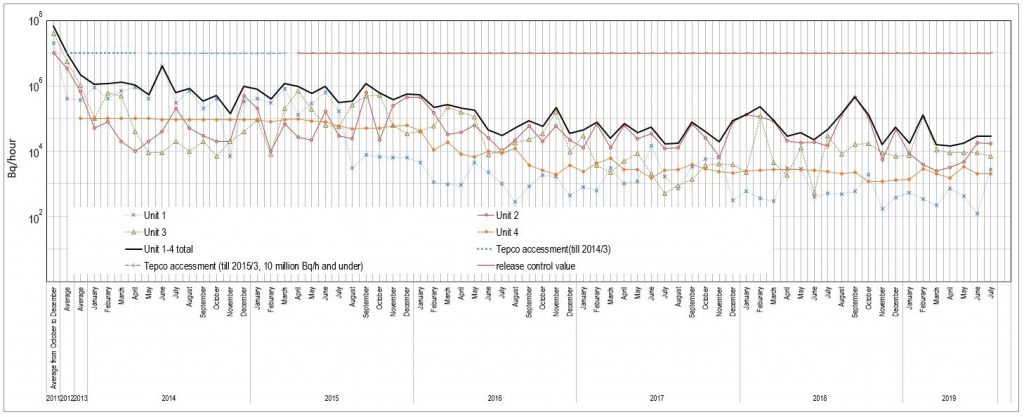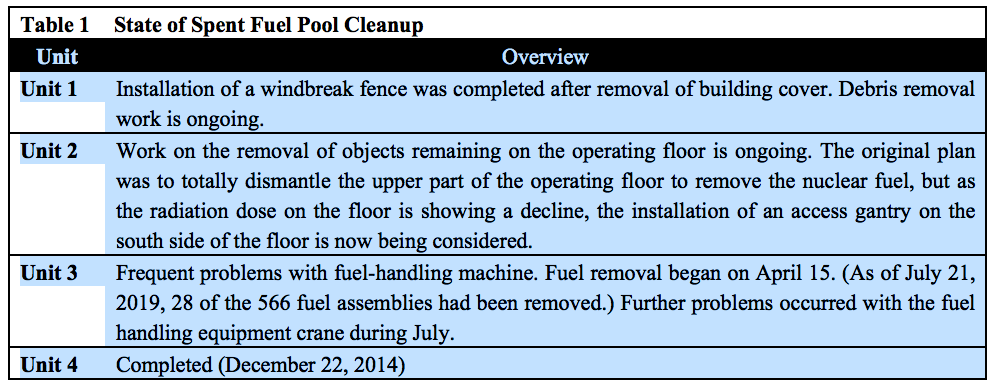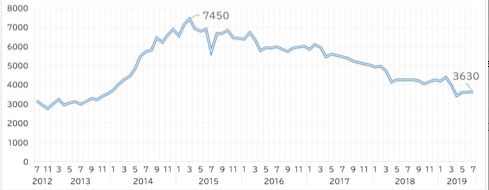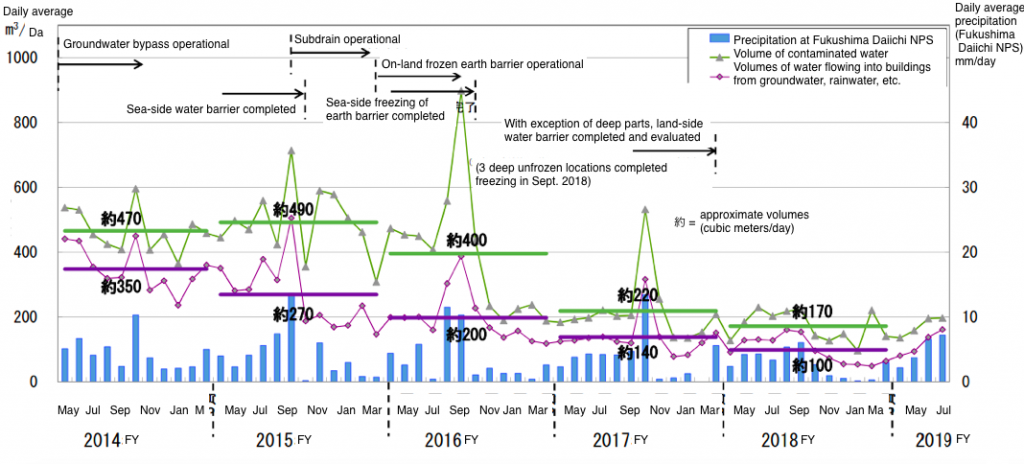Current State of Post-Accident Operations at Fukushima Daiichi Nuclear Power Station (February to August 2019)
By Matsukubo Hajime, CNIC
State of the Plant
The water temperature in the containment vessels and the spent fuel pools (SFPs) varies mostly around less than 30oC and no great changes have been seen. The state of releases of Xenon-135 (half-life roughly nine hours), released when uranium fuel undergoes fission is also unchanged and it can therefore be estimated that the state of the reactors is stable. Further, according to an assessment by TEPCO in July 2019, around 29,000 bequerels per hour (Bq/h) of radioactive materials were being released from the buildings (Fig.1).

At the same time, decay heat has fallen greatly with the passage of time, and thus the volume of cooling water injected into the reactors has been reduced. Since the cooling water becomes contaminated through contact with molten debris, etc. inside the reactors, the reduction in the injected volumes of cooling water leads to a reduction in the accumulation of contaminated water. In April and May of this year, a lowering and a temporary cessation of the injected volumes of cooling water was conducted experimentally in Unit 2. This suspension of injection experiment is also due to be conducted in Units 1 and 3 in the near future.
The state of removal of nuclear fuel from the SFPs is summarized in Table 1. Nuclear fuel removal from Unit 4 has been completed. While multiple problems have been experienced with the equipment (fuel handling equipment crane and fuel-handling machine) for removal of spent fuel from Unit 3, removal began on April 15, 2019. (It was originally set to begin around mid-FY2018.)

Work to dismantle the upper section of the Units 1 and 2 exhaust stack, in which a fracture was discovered in a supporting pillar, began on August 1. The plan is to dismantle the 60m exhaust stack by dividing it into 23 blocks. Currently, dismantling work is ongoing on the uppermost part, but the work has been delayed by equipment troubles and adverse weather conditions. Creation of a landfill using the megafloat used to store contaminated water in 2011-12 (a move from in front of Units 5 and 6 to in front of Units 3 and 4 completed on May 16, scheduled for landfill completion in FY2021) as well as other tasks are now underway.
Changes in the number of workers per day are shown in Fig. 2. As of July 2019, the number was 3,630, roughly half what it was at the peak of 7,450 as of March 2015. At the same time, while the work environment is said to have improved, it is still severe. While there were five heat stroke victims up to the end of September FY2017 and seven in FY2018, there were seven up to the end of August FY2019.

Fig. 2: Change in Average Number of Workers (Actual Values) Per Day on Weekdays
State of Contaminated Water
Contaminated water countermeasures at Fukushima Daiichi Nuclear Power Station (FDNPS) can be broadly divided into three areas: 1) Reduction of groundwater flowing into buildings, 2) Reduction of contaminated water flowing into the sea, and 3) Reduction of the toxicity of contaminated water. Regarding the reduction of water volumes flowing into buildings, the main countermeasures are, from higher elevations downward, A) Pumping up groundwater at the groundwater bypass and releasing it into the sea (491,225m3 up to August 27), B) Installation of a frozen earth barrier (on-land water barrier, total length roughly 1,500m) surrounding FDNPS Units 1-4. (Ground temperature has now reached below 0oC except for one section.) C) Pumping up water at the subdrains and releasing it into the sea (746,091m3 up to August 27, 2019), and D) Paving of the site with asphalt to suppress permeation of rainwater into the soil. Regarding reduction of contaminated water flowing into the sea, the countermeasures being taken include A) Groundwater leakage prevention by a steel water barrier on the sea side, B) Pumping up of groundwater dammed up behind the sea-side water barrier from the well points and groundwater drains. (roughly 210,003m3 up to August 27; as this groundwater is highly contaminated, it is being transferred to the turbine building), and other measures. Changes in generated volumes of contaminated water are as shown in Fig. 3.)

Regarding the reduction of the toxicity of contaminated water, after removal of cesium and strontium and removal of impurities using reverse osmosis (RO), radionuclides except for tritium are removed by the multi-radionuclide removal equipment (ALPS – Advanced Liquid Processing System) and then stored in tanks (containing 1,054,927m3 as of August 22. However, due to equipment malfunctions and other problems, in many cases radionuclides other than tritium are present, only around 20% of the stored water being below the notification concentration). Besides this, water remaining in buildings is roughly 31,810m3, strontium-treated water, etc. is 88,570m3, water treated by RO is 9,831m3, concentrated brine is 500m3, concentrated wastewater is 9,303m3, etc.
Furthermore, the Subcommittee on the Handling of Water Processed by ALPS, etc. met for the first time in eight months on August 9. As a result of large numbers of opposing views against release of water processed by ALPS into the ocean at a public hearing held by the subcommittee in August 2018, the subcommittee has this time decided to also consider long-term storage options.

